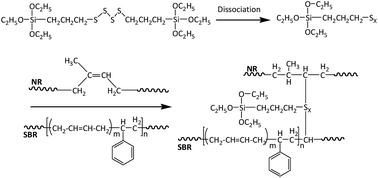Recycled tyre rubber-thermoplastic composites through interface optimisation
Abstract
This paper presents the development of a rubber–polyethylene (PE) composite based on recycled materials with the aim of its interfacial optimisation by the use of maleated and silane coupling agents (maleated polyethylene (MAPE), bis(triethoxysilylpropyl)tetrasulfide (Si69) and vinyltrimethoxysilane (VTMS)). ATR-FTIR analysis revealed (1) the macromolecular entanglements between the grafted PE moiety in MAPE and the polymer chains of both rubber and PE in the composite, and (2) the chemical crosslinking between dissociated Si69 and rubber molecules followed by the entangling with PE polymer. These chemical interactions benefited the improvement of the constituent compatibility, rubber wettability, and interfacial adhesion of the corresponding composites, which were evident in SEM observations. The higher loss moduli, shift of glass transition peaks and inferior tan δ of the treated composites indicated the segmental immobility of the macromolecules after the treatments, which was confirmed by the NMR analysis by showing comparatively broader resonance peaks. The optimised interface led to the increase of the mechanical properties of the composites including storage modulus, tensile stress and strain. VTMS treatment was not as effective as MAPE and Si69 treatments in terms of interface refinery and property strengthening.



 Please wait while we load your content...
Please wait while we load your content...